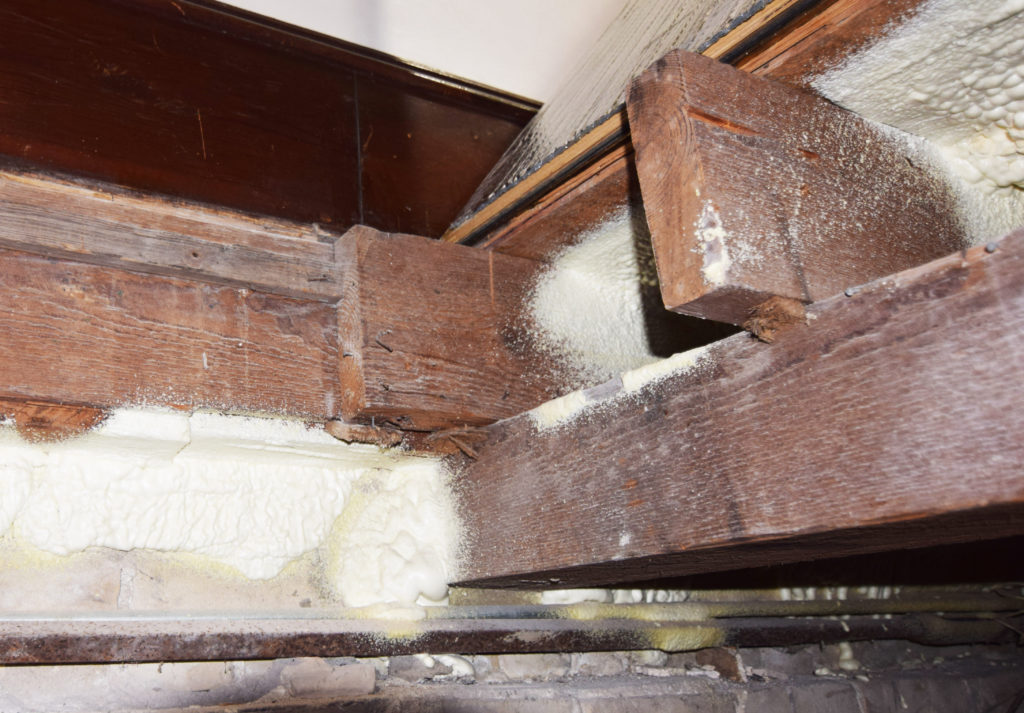Resilience Treatments & Strategies
Floor Structure

Description
Part of your building’s superstructure (the building’s load-bearing elements) that supports each occupiable story. Typical components may include a subfloor (e.g., boards or plywood) on top of frame members (e.g., beams or joists). Framing is often wood, although metal or concrete framing is also common in larger buildings. Masonry vaulting may be found in many historic buildings. The ground floor level, or finished floor elevation, is an important consideration for resilience against flooding.
Typical risk factor of this component:
Low
The floor structure has little exposure to elements such as wind and water. Localized damage should not impair the structure’s overall stability and the impact a partial failure might have on other assemblies is relatively low.
Typical Damages from Floods or Hurricanes
- Floor joists or beams have wet/dry rot
- Structural connections loose or damaged
- Wood frame members have become waterlogged and are buckling, bowing, cupping, or swelling
- Substantial pest/insect infestation (e.g., termite damage in wood members)
- Uneven settling (a.k.a. differential settlement) between building areas or elements
- Deflecting or sagging joists or beams
- Concrete carbonizing (losing alkalinity), possibly causing spalling around reinforcement bars within
Other common conditions contributing to vulnerability towards floods or hurricanes
- Floor framing not protected with coatings or treatment
Resilience Treatments and Strategies
In-house
Air out the building immediately following water infiltration and saturation, limiting the use of forced ventilation to avoid drying surfaces too quickly. If mold is present, consult specialists that treat hazardous materials.
Investigate (with non-destructive or easily reversible methods) to determine if structural components are damaged (may require a professional, depending on the material and access).
Professional needed [type]
Reinforce the joists and their connections with structural stiffening members to improve strength to forces such as rapid-moving floodwaters [engineer].
Repair or replace damaged/unstable beams or joists [engineer].
Apply protective or consolidating coatings (e.g., borates, intumescent paint) to floor framing to mitigate risk of damage [architect].
Floor Structure

Description
Part of your building’s superstructure (the building’s load-bearing elements) that supports each occupiable story. Typical components may include a subfloor (e.g., boards or plywood) on top of frame members (e.g., beams or joists). Framing is often wood, although metal or concrete framing is also common in larger buildings. Masonry vaulting may be found in many historic buildings. The ground floor level, or finished floor elevation, is an important consideration for resilience against flooding.
Typical risk factor of this component:
Low
The floor structure has little exposure to elements such as wind and water. Localized damage should not impair the structure’s overall stability and the impact a partial failure might have on other assemblies is relatively low.
Typical Damages from Floods or Hurricanes
- Floor joists or beams have wet/dry rot
- Structural connections loose or damaged
- Wood frame members have become waterlogged and are buckling, bowing, cupping, or swelling
- Substantial pest/insect infestation (e.g., termite damage in wood members)
- Uneven settling (a.k.a. differential settlement) between building areas or elements
- Deflecting or sagging joists or beams
- Concrete carbonizing (losing alkalinity), possibly causing spalling around reinforcement bars within
Other common conditions contributing to vulnerability towards floods or hurricanes
- Floor framing not protected with coatings or treatment
Resilience Treatments and Strategies
In-house
Air out the building immediately following water infiltration and saturation, limiting the use of forced ventilation to avoid drying surfaces too quickly. If mold is present, consult specialists that treat hazardous materials.
Investigate (with non-destructive or easily reversible methods) to determine if structural components are damaged (may require a professional, depending on the material and access).
Professional needed [type]
Reinforce the joists and their connections with structural stiffening members to improve strength to forces such as rapid-moving floodwaters [engineer].
Repair or replace damaged/unstable beams or joists [engineer].
Apply protective or consolidating coatings (e.g., borates, intumescent paint) to floor framing to mitigate risk of damage [architect].